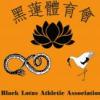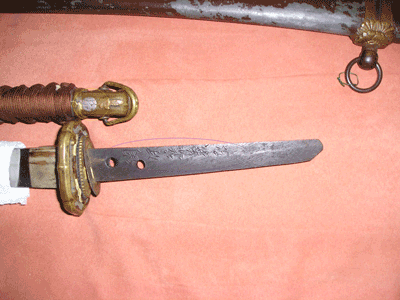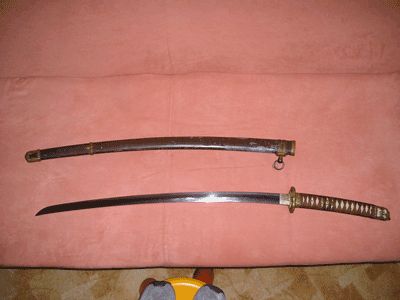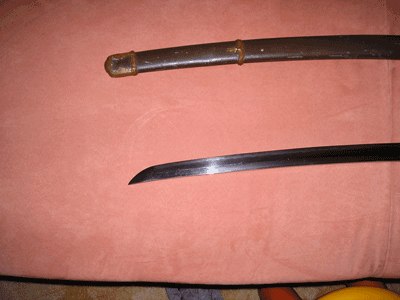-
Posts
8,372 -
Joined
-
Last visited
-
Days Won
20
Content Type
Profiles
Forums
Events
Store
Downloads
Gallery
Everything posted by John A Stuart
-
Hi Nobody, I tried to magnify the pics in photoshop when I downloaded them from Yahoo, but, they lost definition and I could not make out the mei very well. I hope MH sends me a better pic of the tang as well. John
-
Hi MH, I converted you jpeg's to gif's and reduced the file sizes to less than a tenth, otherwise I did nothing else to the pics. They were large files not 140 kb but between 1400 kb and 1600 kb in original form. I really would like to see a better pic of the tang. John
-
Hi Milt, I do not know how they would do it except as being cast. When I look at the larger pic I see what looks like imperfectly cast nanako which would be expected with fine casting. Not to say this is the case though just what the appearance suggests. Saying that and not knowing it was not cast I would have thought it a Kagami-shi piece. Not too old you think? Late Edo? It is an attractive tsuba. I hope the experts solve this conumdrum. John
-
Hi, This is a point where opinions abound. So these are my thoughts. To the collector of nihonto for its artistic merit a blade would be unacceptable when the wear overwhelms the artfulness of the sword. Certain swords of immense provenance would be viewed with a less critical eye. Collectors with a more historical bent would see a value that relates to the study of a sword to ascertain certain data or fill a smith or period niche. With this in mind I am sure most judges would think in a similar way. A sword newly discovered by a smith known to have existed but never had an example extant, even though 'ruined by general standards' would still be an immensely valued object. John
-
MH, Just send it to my email and I will post it for you. John
-
Kuat, Go through the links at the page top of commercial sites. There are quite a few that deal with shinsakuto like Usagiya for example. They have quite a range in price and depending on what you will use them for a lot of choices. John
-

A sword stand with class...
John A Stuart replied to S.Haugtredet's topic in Auctions and Online Sales or Sellers
Hi Justin, This is as I was told. Tsuka to the left when in an harmonius setting and to the right when in a guarded setting. You will see this with more positions when in seiza, all showing various degrees of wariness and respect. It has to do with the readiness with which the sword may be brought to bear. John -
Hi Brian, I tried it out and it works great. I suggest a link back to that page from the board similar to 'home' so you do not have to exit the site and re-enter to reach that page. Unless I missed something. Thanks, John
-
Hi, I can not tell if it is umegane or fukure but it's not bad. Blade seems fine but pic doesn't show detail. I have a hard time photographing these too. No gift. Why do you think Bungo? The yahoo pic site needs password access so I do not think some will be able to view these pics. John
-
A very reputable man. John
-
Hi MH, I tried to clean up the mei in photoshop to try and decipher it, but there is not enough pixels. Could you post some here that have more definition? Not my area of study really but trying to help educates me as well. John
-
Hi Mike, The Yamashiro-den did have within it kaji who produced swords with suguba hamon of different kinds as well as hamon based on suguba among others. Within the Echizen-ha midare of different types is common but the others I mentioned were produced as well. In Sagami there was notare based on suguba. During these times there was so much movement and interaction of kaji that hamon of various schools could be found within any particular Ha. For example: Echizen- ha, mixture of Yamato and Soshu; Sagami strong Soshu influence; Shimosaka, Yamashiro, Soshu. John
-
Hi Mike, The info I have is sketchy on the Shimosaka line which it seems came from Yamashiro and Omi, but whithin the Echizen Ha is mentioned that it includes Hirosuguba with Ashi and Chusuguba with tight Nioi and Hitatsura. John
-
Hi Ken, The tsuba has nice subdued work of good quality. The steel looks like it was intended to have this primitive look. The work and the tsuba bring to mind Tsuchiya 18th cent. and again Tosho is a possibility. John Oh, by the way my daughter watches a lot of Japanese anime and says the rabbit looks happy. Is the F/K Mino Kinko? J
-
Ah yes, Nobody, The first kanji reading Hi (zen) leads to Tada (yoshi). When I read it as Bi (zen) the Tada seemed to be Mune. Hard to read being so loose, for me and so similar. John
-
Hi, Luckily, I had the password to view your pics. A gunto, WW II vintage sword. Hard to identify until I download the pics and magnify the mei but, just off the cuff, it is a mass produced sword with an oil quenched hamon. Tonight I'll get more info unless some other has done it. John
-
Hi Andreas, It seems to read 'Bizen Kuni Ju Muneyoshi'. #1 kanji is a little odd and the whole mei is loose to read. John PS- It would be nice to see the whole thing. J.
-

of cultural interest...........may be
John A Stuart replied to Bungo's topic in General Nihonto Related Discussion
Guys, It does not seem to be to far divorced from activities that have always surrounded Buddhist temples. Take for example the entrance to Kannon at Akasaka, a great place to shop and eat and is on temple ground after the gate. Revenue goes to the temple for rents. In Thailand right in the walled compounds you may buy trinkets, food and even get a massage. It goes on, in Singapore you can buy incense, firecrackers etc. for festival days. Macau like-wise. I saw less in China, but I'm sure it exists, a lot of temples seem to be up-kept by the state, if at all. There has always been religious items for sale, censors, mandalas etc. Upkeep of these temples is expensive and a great repository of learning and I think that the modernisation of services is a great way to preserve these sites and attract people to reinvestigate a way of thought. Excuse my bias, but it is a good idea. John -
Deron, Brian, Is it not that shakudo with a lower gold content would show a lighter colour and require the 'treatment' to darken the surface to make it more desirable whereas a better quality alloy of higher gold content would not require this patination procedure and not show the copper looking wear pattern from use (rubbing). I have noticed nicks in good pieces that show the metal is dark underneath as well. Not knowing if this is the case, just my observation. John
-
Hi Danny, The hamon is hososuguba and very hard to see activity within. No nijuba for certain. There is nie along the edge of a nioi matrix. The boshi is omaru. A very simple blade . It has a bohi that was added, I think, later to reduce weight. I wish I could have seen it before it was cut. John http://www.johnstuart.biz/new_page_4.htm Here are photos.
-
Great article Danny, It gives me food for thought on the o-suriage ko-mihara that I have. Mine shows none of the activities in the jihada mentioned being a very tight itame. So tight the chirimen description becomes possible but with no roughness mentioned. This tachi is very heavy as swords go and makes me believe it was carried by attendants to battle. The motohaba and sakihaba are both 0.7cm, pretty robust, I must say. Anyhow, keep 'em coming. John
-
Hi Curran, Yes, I have those books, but, the Minoto Taikan I have is all Japanese and reference to info there will take me awhile. What really interests me (and I want to include on my site) is during the diaspora of Mino smiths who remained in Mino and who ended up in Owari. The Owari connection is as I have stated but it seems the times were rather hectic and records sketchy. I hope to have more as I translate the pertinent section in the Minoto Taikan but was hoping someone had studied this line or knew an English reference other than those you mentioned. Thanks, John
-
Hello All, I am having trouble finding much information on the Jumyo Ha during the Shinto period. It seems to be rather sketchy. If any know some more about it please let me know. What I have been able to collate so far is here: http://www.johnstuart.biz/new_page_15.htm I would like to know where additional info may be obtained. Thanks, John
-
I read the book some years ago. It was one fantastic feat of engineering and one sad end to the battleship era. Its' final days being used as a floating anti-aircraft platform, the massive 18" guns being destroyed firing beehive rounds during Japans' last defensive gasp. I recommend it. John
-
Oh I see. That is best. However an expense for an average sword. John




